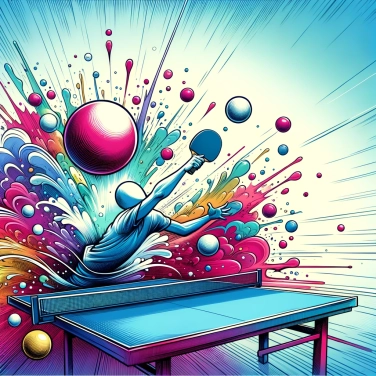The ball bounces so high in table tennis because of the speed at which it is hit and its bounce on the hard surface of the table, which gives it a significant spin and bounce effect.

A table tennis ball is made mainly of plastic, more specifically of synthetic materials like polypropylene or ABS, which gives it its characteristic lightness. It is hollow inside, filled only with air, which ensures its low weight (about 2.7 grams) and allows for excellent elasticity. When the ball hits a hard surface, its plastic structure briefly deforms and quickly returns to its original shape due to this elasticity. This mechanism allows the ball to return a large part of the energy received upon impact, thus promoting a particularly high and lively bounce. The higher the elasticity and quality of the material, the more efficiently the ball will bounce.
The surface of the table has a direct effect on the bounce due to its generally smooth and uniform coating, usually made of wood covered with a specific paint. When it is hard and rigid, the ball bounces high because less energy is absorbed by the table. In contrast, a surface that is too soft slows down the ball; it bounces less vigorously because much of the energy is lost in the deformation of the material. The slightly rough texture of the paint also helps to grip the ball slightly, influencing the spin and making it easier to control. A good balance, indeed: smooth enough for a strong bounce, but with just the right amount of grip to feel the impact and manage the trajectory.
The spin applied to the ball clearly changes its bounce height. By putting topspin— that is, by brushing the ball from bottom to top— it will rotate forward, resulting in a significantly higher and sharper bounce. Conversely, a backspin causes the ball to rotate backward (friction from top to bottom), which tends to slow down its bounce and especially flatten it, resulting in a low and difficult-to-attack rebound. A side spin will also influence the bounce trajectory, but mainly to the sides rather than truly in height. This variation in bounces is primarily due to the friction between the spinning ball and the table surface, which alters the direction and energy of the rebound.
The harder you hit the ball, the more it accumulates kinetic energy. At the moment it hits the table, this energy is released all at once, causing it to bounce significantly higher. Basically, a fast and powerful ball compresses more upon impact, deforms a little more, and quickly regains its original shape by pushing violently against the surface. It is this lightning deformation that allows for an explosive and spectacular bounce, typical of fast exchanges in ping-pong. Conversely, when the ball is struck gently, it stores much less energy, resulting in no high bounce.
When the ball hits the table, the impact angle directly determines the trajectory of the rebound. The closer the impact is to vertical (the ball falling almost straight down), the higher the ball will bounce. Conversely, a very flat impact, like on a very tight shot, causes the ball to move forward rather than upward. This clearly means that the more your ball hits the table at a steep angle, the higher the rebound you’ll get. On the other hand, striking the ball with a much more closed angle sends it straight forward, close to the surface, and keeps it on a low trajectory. Adjust your angle, and you directly control the height of your rebound: it may seem simple, yet it’s essential.
Official table tennis competitions require complete uniformity of the playing surface. Thus, even the slightest defect or irregularity in the table can have a significant impact on the height and direction of the bounce.
A regulation table tennis ball must bounce to about 23 cm when dropped from a standard height of 30 cm onto a standard steel plate. This test ensures uniformity and consistency during competitions.
The official diameter of a table tennis ball slightly increased from 38 mm to 40 mm in 2000, in order to slow down the game a bit and thus provide more spectacular and understandable rallies for spectators.
Originally, table tennis balls were made of celluloid, but since this material is highly flammable and difficult to transport, they have been mainly made of polymer plastic since 2014.
According to official standards, a ball dropped from a height of 30 cm must bounce between 23 and 26 cm to comply with the international table tennis rules set by the ITTF (International Table Tennis Federation).
Sure. The height of the bounce can vary depending on the composition, thickness, and quality of the table surface. A perfectly flat surface made of dense material promotes a more uniform and predictable bounce.
The spin applied to the ball significantly modifies its bounce. A topspin results in a higher and faster bounce, while a backspin reduces the height of the bounce and tends to slow the ball down upon hitting the table.
Table tennis tables are primarily made of wooden panels covered with a special paint that has a matte finish to optimize the ball's spin and bounce. Some high-end models use composite materials coated with specific layers to further enhance performance.
The ball is hollow to ensure lightness and elasticity. This allows for optimal bounce on the table while minimizing air resistance during play.

No one has answered this quiz yet, be the first!' :-)
Question 1/5